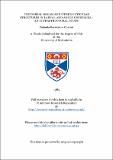Files in this item
The dorsal organ and other cuticular structures in larval and adult crustacea : an ultrastructural study
Item metadata
| dc.contributor.advisor | Laverack, M. S. | |
| dc.contributor.author | Barrientos Chacon, Yolanda | |
| dc.coverage.spatial | vi, 113 p. | en_US |
| dc.date.accessioned | 2018-06-26T16:40:22Z | |
| dc.date.available | 2018-06-26T16:40:22Z | |
| dc.date.issued | 1985 | |
| dc.identifier.uri | https://hdl.handle.net/10023/14644 | |
| dc.description.abstract | SEM observations on the integument of larvae and adult Crustacea Malacostraca indicated differences in setal armature, and in types and frequency of occurrences, which seem to be related with development and sensilla body position. The Amphipoda and Isopoda species studied share a common type of articulated conical spine on the pereiopod segments. In each species, the conical spine has a modified apex which contains sub-apical setules whose tips are provided with ventrally positioned pores or bifid ends. The epimeral and lateral body plates are covered by short articulated pegs with modified hair bases: asymmetrical lip-like extensions, knobs or vesicle-like projections around the hair rim. An unusual type of aesthetasc sensillum is present on the male Cumacea antennal flagellum. A sub-terminal and ventrally positioned pore is present in these aesthetascs whose tips are divided. Companion and guard hair sensilla are absent. A number of cuticular out/ingrown structures are described in both Decapoda and non-Decapoda Crustacea which cannot be related with any previous classification schemes. Crustacea Decapoda larvae (Macrura, Anomura, and Brachyura) have a common trichoid sensillum, whose numbers and distributional patterns are specific for each group. There is a tendency for the trichoid sensilla to be arranged in clusters rather than describing ramdon patterns. Setal organization changes according to developmental instars: larva and post-larval forms have small numbers and types of sensilla, or in some cases they possess the incipient forms of receptors such as the funnel-canal organs known to be present in the pereiopods of adult animals. Juvenile stages exhibit a more complex and sophisticated setal arrangement. Brachyura stage IX-X embryos and hatchling larvae are equipped with well anatomically organized (TEM) sensory hairs. According to their ultrastructural features potential mechano-, and chemoreceptive hairs can be differentiated in the antennules and maxillipeds. In the dorsal median anterior region of the head, Decapoda larvae possess a discrete organ: glandular-sensory complex. Its external topography reveals the presence of one or two central pores (Brachyura, Anomura) or a poreless central area (Macrura) surrounded by four equidistant plate-pits which contain a central pimple or cone. The Macrura plate-pits lack the central cone but develop a row of diminutive pegs. The dorsal organ ultrastructure reveals several components: a gland cell, a ductule cell, two supporting cells and eight sensory cells. The gland cell components allow it to be categorized it as an excretory class 3 gland cell; and the presence of two biciliary sensory cells per plate pit, without scolopale matrix and thick dendritic sheath may identify them as potential chemoreceptors or as bimodal sensitive units. SEM observations indicated that the organ is not present in the integument when juvenile stages are reached. The organ might degenerate or internalize. No definitive function can yet be ascribed to the organ. | en_US |
| dc.language.iso | en | en_US |
| dc.publisher | University of St Andrews | |
| dc.subject.lcc | QL444.B2C5 | en |
| dc.subject.lcsh | Crustacea | en |
| dc.title | The dorsal organ and other cuticular structures in larval and adult crustacea : an ultrastructural study | en_US |
| dc.type | Thesis | en_US |
| dc.contributor.sponsor | Sir Harold Mitchell Fund | en_US |
| dc.contributor.sponsor | Institutio Universitario Pedagogico de Caracas | en_US |
| dc.type.qualificationlevel | Doctoral | en_US |
| dc.type.qualificationname | PhD Doctor of Philosophy | en_US |
| dc.publisher.institution | The University of St Andrews | en_US |
This item appears in the following Collection(s)
Items in the St Andrews Research Repository are protected by copyright, with all rights reserved, unless otherwise indicated.

